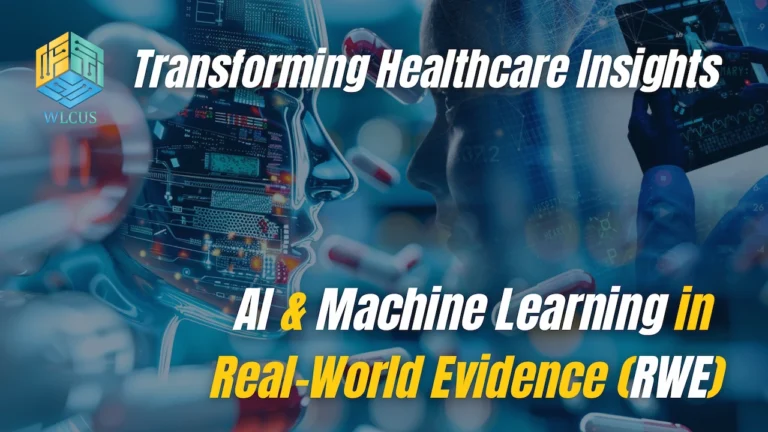AI & Machine Learning in Real-World Evidence (RWE):
Transforming Healthcare Insights

Real-World Evidence (RWE) has become a powerful resource for healthcare innovation. It uses real-world data from sources like electronic health records, insurance claims, registries, and patient-reported outcomes to evaluate medical products and patient care.
Artificial Intelligence (AI) and Machine Learning (ML) are reshaping how RWE is collected, analyzed, and applied. They allow healthcare providers, researchers, and regulators to process large datasets quickly, identify patterns, and generate actionable insights.
By combining AI with RWE, the industry can improve drug development, accelerate approvals, and deliver safer, more personalized treatments.
This blog explores the relationship between AI, ML, and RWE, highlighting benefits, applications, challenges, and future directions.
Understanding Real-World Evidence and Its Growing Role in Healthcare
RWE is evidence derived from analyzing real-world data (RWD) outside of controlled clinical trials.
Unlike randomized controlled trials, which test drugs in structured settings, RWE reflects how treatments perform in everyday healthcare.
Sources of RWD include:
Electronic Health Records (EHRs)
Medical claims and billing data
Disease registries
Patient-generated data from apps and wearables
Pharmacy and lab records
Regulators like the FDA and EMA are increasingly incorporating RWE into decision-making.
Pharmaceutical companies use it to understand drug performance across diverse populations.
Payers rely on it for value-based care models and reimbursement decisions.
The growing adoption of RWE reflects the need for cost-effective, real-world insights.
However, analyzing large, unstructured data sets remains complex, this is where AI and ML provide value.
How AI and Machine Learning Enhance RWE Studies
AI and ML enable scalable analysis of massive healthcare datasets.
Traditional statistical methods often fail to manage the complexity and volume of modern RWD.
AI models, however, can recognize subtle correlations, adapt to new inputs, and deliver predictive insights.
Improving Data Quality and Accuracy
Healthcare data often contains errors, missing values, or inconsistencies.
Machine learning algorithms can:
Identify duplicate or conflicting entries
Fill missing values using predictive methods
Standardize formats across systems
Natural language processing (NLP) extracts valuable information from physician notes and unstructured records.
This improves both the completeness and reliability of RWE datasets, allowing better clinical and regulatory decisions.
Enabling Predictive Analytics in RWE
AI transforms RWE into predictive tools.
By analyzing historical patient data, ML models can forecast:
Disease progression
Treatment response
Risk of adverse events
This predictive capability helps clinicians intervene earlier, regulators anticipate safety issues, and payers design proactive care models.
It turns retrospective data into forward-looking insights that guide healthcare decisions.
Key Applications of AI and ML in RWE
The combination of AI and RWE is driving innovation across drug development, safety, and patient care.
Drug Development and Approval
Pharmaceutical companies use AI-enhanced RWE to shorten drug development timelines.
ML models analyze patient data to identify eligible populations for trials, simulate outcomes, and support regulatory submissions.
This approach lowers costs and reduces the time to bring new therapies to market.
Post-Market Safety Monitoring
RWE is critical for identifying rare or long-term side effects after a drug is approved.
AI algorithms scan real-world datasets to detect early warning signals of safety risks.
This improves pharmacovigilance by identifying adverse events faster than traditional reporting systems.
Personalized Medicine Approaches
AI and RWE together enable tailored treatments.
By analyzing genetic, lifestyle, and clinical data, ML models identify subgroups most likely to benefit from specific therapies.
This supports precision medicine, ensuring patients receive therapies best suited to their needs.
Challenges in Applying AI and ML to RWE
Despite benefits, challenges remain:
Data Privacy: Handling sensitive patient information requires strict compliance with GDPR, HIPAA, and local laws.
Bias and Fairness: ML models may reflect existing healthcare inequalities if training data is unbalanced.
Interoperability: Data often resides in siloed systems with varying formats.
Regulatory Acceptance: Agencies require transparent, explainable AI models before approving RWE-based submissions.
Overcoming these challenges requires collaboration between regulators, data scientists, and healthcare providers.
The Future of AI in Real-World Evidence
AI adoption in RWE will continue to grow as healthcare shifts to value-based care.
Advancements in deep learning, federated learning, and explainable AI will improve trust and scalability.
Wearable devices and remote monitoring will generate more patient-centered RWD for analysis.
Future trends include:
AI-driven adaptive clinical trial designs
Integration of RWE with genomic data for precision healthcare
Broader regulatory acceptance of AI-based evidence
The result will be faster innovation, safer treatments, and healthcare that adapts more effectively to real patient needs.
From RWD to RWE: AI Application and FDA Relevance
AI and machine learning are changing the role of RWE in healthcare. They make large datasets usable, enhance safety monitoring, accelerate drug approvals, and support personalized care.
While data privacy and regulatory hurdles remain, the opportunities are significant. As AI continues to advance, RWE will provide even greater value in shaping medical decisions, improving patient outcomes, and reducing healthcare costs.
The Future is Now
The shift from RWD to RWE, powered by AI and supported by regulators like the FDA, EMA are more than a technological evolution, it’s a healthcare revolution.
At WLCUS, we believe fostering collaboration between data scientists, clinicians, regulators, and pharma leaders is the key to unlocking the full potential of real-world insights.
